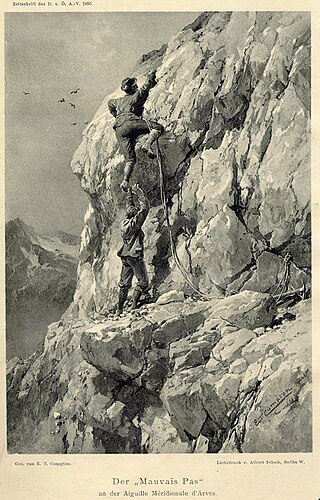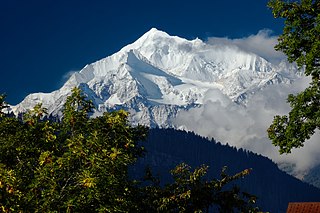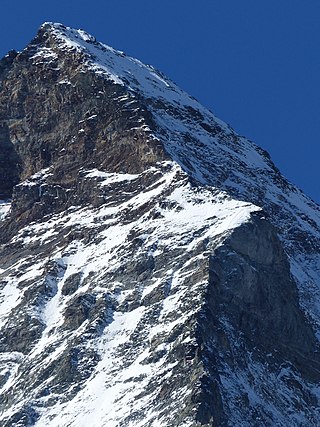Werner Munter (born 1941 in Lohnstorf, Switzerland) is a mountain guide, author and safety-expert for Alpine climbing.
Munter, who lives in Vernamiège near Sion, Switzerland, introduced the 'Halbmastwurf' as a belay hitch for climbing. American-English-speaking climbers know this knot as the Munter hitch, but in the United Kingdom it is more commonly known as the Italian hitch.
Munter became especially well known during the 1990s by his books on avalanches. These led to a shift of paradigm in the practical assessment of avalanches. The so-called '3 × 3 Filter- und Reduktionsmethode' is a probabilistic strategy of decision for winter mountaineers (especially ski mountaineers) for the assessment of avalanche risks in unprotected alpine areas. Munter's works triggered intensive discussions among mountaineers and mountain guides. Meanwhile, his 'Reduktionsmethode' (method of reduction) or similar decision strategies (Engler, DAV: Snowcard, Larcher/OeAV: Stop or Go) are now routinely taught by the Alpine Clubs (Alpenvereine).
As of 2005 [update] , Munter is employed at the 'Eidgenössisches Institut für Schnee- und Lawinenforschung' (Swiss institute for research on snow and avalanches) in Davos'.
In 1995, he was proclaimed 'Ehrenbergführer' (honorary mountain guide) by the Swiss association of mountain guides for his merits.
In 1997, he received the 'Eybl-Sicherheitspreis'.

Mountaineering, mountain climbing, or alpinism, is a set of outdoor activities that involves ascending mountains. Mountaineering-related activities include traditional outdoor climbing, skiing, and traversing via ferratas that have become sports in their own right. Indoor climbing, sport climbing, and bouldering are also considered variants of mountaineering by some, but are part of a wide group of mountain sports.

The Zugspitze, at 2,962 m (9,718 ft) above sea level, is the highest peak of the Wetterstein Mountains as well as the highest mountain in Germany. It lies south of the town of Garmisch-Partenkirchen, and the Austria–Germany border runs over its western summit. South of the mountain is the Zugspitzplatt, a high karst plateau with numerous caves. On the flanks of the Zugspitze are two glaciers, the largest in Germany: the Northern Schneeferner with an area of 30.7 hectares and the Höllentalferner with an area of 24.7 hectares. Shrinking of the Southern Schneeferner led to the loss of glacier status in 2022.

Pumori is a mountain on the Nepal-China border in the Mahalangur section of the Himalayas. Pumori lies just eight kilometres west of Mount Everest. Pumori, meaning "the Mountain Daughter" in Sherpa language, was named by George Mallory. "Pumo" means young girl or daughter and "Ri" means mountain in Sherpa language. Climbers sometimes refer to Pumori as "Everest's Daughter". Mallory also called it Clare Peak, after his daughter.

Abseiling, also known as rappelling, is the controlled descent of a steep slope, such as a rock face, by moving down a rope. When abseiling, the person descending controls their own movement down the rope, in contrast to lowering off, in which the rope attached to the person descending is paid out by their belayer.

Duncan "Dougal" Curdy MacSporran Haston was a Scottish mountaineer noted for his exploits in the British Isles, Alps, and the Himalayas. From 1967 he was the director of the International School of Mountaineering at Leysin, Switzerland, a role he held until his death in an avalanche while skiing above Leysin.

Karl Blodig was an Austrian mountaineer, optician, and writer. Blodig was the first to successfully climb all Alpine peaks of over 4000 meters, completing his final summit around 1911. He wrote about these climbs in his book Die Viertausender der Alpen, first published in 1923.

The Munter hitch, also known as the Italian hitch, mezzo barcaiolo or the crossing hitch, is a simple adjustable knot, commonly used by climbers, cavers, and rescuers to control friction in a life-lining or belay system. To climbers, this hitch is also known as HMS, the abbreviation for the German term Halbmastwurfsicherung, meaning half clove hitch belay. This technique can be used with a special "pear-shaped" HMS locking carabiner, or any locking carabiner wide enough to take two turns of the rope.

The Kangshung Face or East Face is the eastern-facing side of Mount Everest, one of the Tibetan sides of the mountain. It is 3,350 metres (11,000 ft) from its base on the Kangshung Glacier to the summit. It is a broad face, topped on the right by the upper Northeast Ridge, and on the left by the Southeast Ridge and the South Col. Most of the upper part of the face is composed of hanging glaciers, while the lower part consists of steep rock buttresses with couloirs between them. The steep southern third of the Kangshung Face also comprises the Northeastern Face of Lhotse; this section may be considered a separate face altogether following the division of the South "Neverest" Buttress up to the South Col. It is considered to be a dangerous route of ascent, compared to the standard North Col and South Col routes, and it is the most remote face of the mountain, with a longer approach.
Rudolf Fehrmann, a German, was a pioneer rock climber at Elbsandsteingebirge near Dresden.

A mountain guide is a specially trained and experienced professional mountaineer who is certified by local authorities or mountain guide associations. They are considered to be high-level experts in mountaineering, and are hired to instruct or lead individuals or small groups who require this advanced expertise. This professional class of guides arose in the middle of the 19th century when Alpine climbing became recognized as a sport.

The Weisshorn is a major peak of Switzerland and the Alps, culminating at 4,506 metres above sea level. It is part of the Pennine Alps and is located between the valleys of Anniviers and Zermatt in the canton of Valais. In the latter valley, the Weisshorn is one of the many 4000ers surrounding Zermatt, with Monte Rosa and the Matterhorn.

The German Alpine Club is the world's largest climbing association and the eighth-largest sporting association in Germany. It is a member of the German Olympic Sports Confederation and the competent body for sport and competition climbing, hiking, mountaineering, hill walking, ice climbing, mountain expeditions, as well as ski mountaineering. It is an association made up of local branches known as 'sections'.

Fürschießer is a mountain of Bavaria, Germany.

Angelo Dibona was an Austro-Hungarian and Italian mountaineer. He is remembered as one of the great pioneers of climbing in the Dolomites and is responsible for many first ascents throughout the Alps. The Aiguille Dibona in France, the Campanile Dibona and the Dibona-Kante on the Cima Grande di Lavaredo are named after him.

A normal route or normal way is the most frequently used route for ascending and descending a mountain peak. It is usually the simplest route.

A mountain sport or Alpine sport is one of several types of sport that take place in hilly or mountainous terrain.
Eduard "Edi" Koblmueller was an Austrian mountaineer.
Pit Schubert is a German non-fiction author, climber and mountaineer. He is the founder and former head of the safety commission of the German Alpine Club (DAV).

The Vorderer Tajakopf is a 2,450-metre-high mountain in the Mieming Chain in the Austrian state of Tyrol.